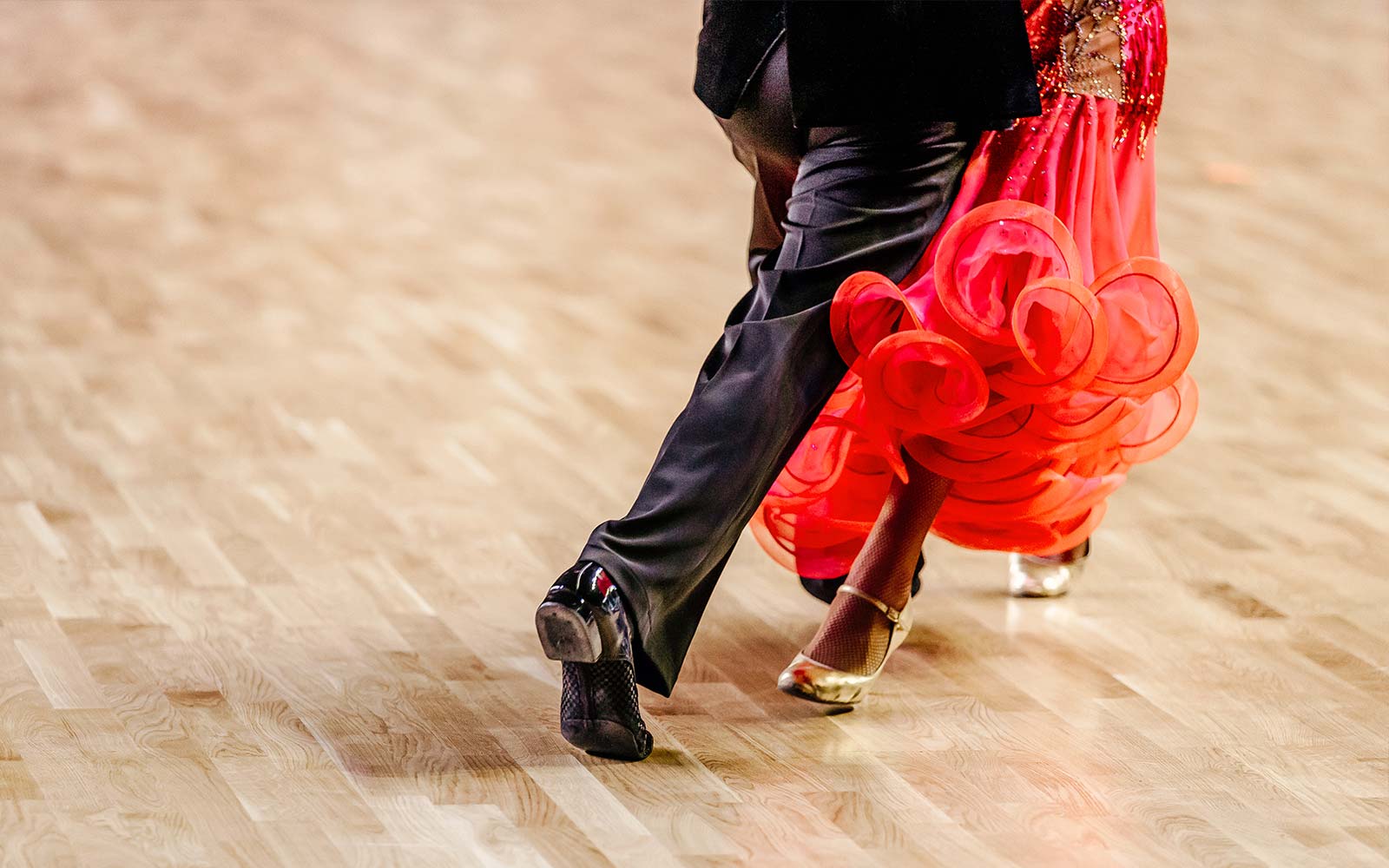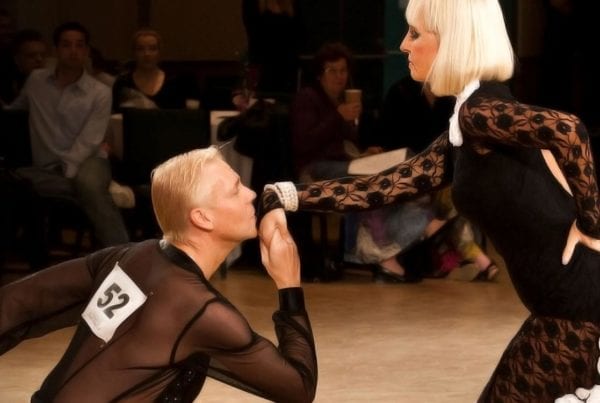When a couple is partnered in a ballroom dance, you have two bodies working together to move as one. There are four legs. Empowering the four legs to move in harmony is one of the most important aspects of good technique.
If you’ve been ballroom dancing for any length of time, especially if you’ve taken classes or private lessons, you already know that the two bodies must be joined together in a specific way in order to move in harmony. But there is much more to creating flowing movement, especially in some dances such as Quickstep.
For example, take the common combination of Open Natural and Running Finish. Although a Bronze sequence, this isn’t an easy one. This combination of steps moves along the floor, switching constantly from having the man move forward outside partner, to the lady moving forward outside partner. These switches lead to a host of common problems, especially if the choreography switches to Promenade Position as the couple begins each Open Natural action.
One of the best ways to evaluate the movement of this sequence is to spend some time analyzing the four legs of the couple and how those legs are positioned in relation to the bodies and head weights of the couple.
First, let’s consider the leg action itself. In this sequence, much of the foot action takes place on the toes. In Ballroom dances, the word “toe” refers to the front part of the foot from the beginning of the arch to the edge of the toes. It isn’t strictly the toe as you might use in Ballet. But we utilize the ankles and knees to keep the upper body from wasting energy due to bouncing up and down. You can experience this by lifting your heels off the floor and allowing your ankles and knees to bend so that the upper body stays more or less in one place.
Experiment some more by seeing what happens if you move the head around while you do this. Notice how it is now hard to stay balanced?
Three Centers
Our bodies can be thought of as having three parts to the “center.” The first part is between our neck and rib cage. The second part is from our rib cage to our waist. The third part is from our waist down to just above our knees. Each of these parts needs to move independently in order for the bodies to move together in true harmony. In some figures or actions, the connection will be through all three of these parts. In other actions, only one of these three parts might be connected, while the other parts can separate and move somewhat differently. You can practice the isolation of these parts by trying to rotate from left to right with each of these three sections.
We need to keep our centers aligned towards our partner. If the couple opens their center, the hips end up in a side-by-side position. When this happens, the four legs end up side-by side. Kind of like a chariot with two side-by-side horses. Not only does this look unattractive, but it makes it virtually impossible to move efficiently back into closed position through a figure like the Open Natural.
When we turn to Promenade Position, the upper part of those three center sections should be only slightly open from our partner. The head needs to be held over the spine. Too often, especially in the rapid movement of Quickstep, the head starts getting ahead of the spine, causing the legs to be left behind. The center part of those three sections is held towards our partner, while the bottom section must be, like the top, somewhat diagonal to our partner so that there is room for our legs to swing through and across the standing leg. When these parts are aligned, the two back legs have room and move forward in perfect harmony, with neither partner pulling the other out of position by the weight of a leading head.
In addition, many dancers turn the feet too far into the line of dance when in Promenade Position. Again, this leads to the hips being side-by-side and ruining the harmony of the four legs. The feet must be positioned at an angle of 90 degrees to your partner (45 degrees in relation to the LOD). In this way, the legs can smoothly move through the standing leg, maintaining a smooth energy for the couple as a whole.
The importance of head position
Never underestimate the impact of the head weight. Our heads weigh, on average, 12-14 pounds. Think of a medicine ball like the kind you use in a gym. When a heavy ball like that gets rotating, it can pull the entire body out of alignment. We already discussed what happens when the head comes forward.
Likewise, if the head is held too far back, it keeps the couple from moving through, causing one partner to end up too far in front of the other. As the exercise at the start illustrates, if the head ends up outside the balanced center of the couple, it pulls the bodies out of alignment with the four legs underneath, causing problems with the movement of the couple.
As we transition from Promenade Position to Closed Position in the Open Natural, we must use CBM (Contra Body Movement) which allows centrifugal force to assist with the rotation. The gentleman then needs to open all three elements of his right side to create the “open” action which enables the Running Finish. If he is late, the two bodies will remain in Closed Position, hindering the lady from swinging her right leg outside the man. If he is too early, or if he leaves his head behind in this movement, the lady will end up too far past the man’s body and the four legs will be out of alignment.
The Running Finish consists of strong swinging action with the legs. But as the Running Finish completes, the bodies must remain over the standing leg so that they can move effectively into the next Promenade Position.
The final issue that often ruins the harmony of the four legs is when the head turns too late or too early when going into Promenade. If the heads rotate too quickly, the bodies tend to open up too much, leading to the first problem we discussed. And if they open too slowly the couple ends up behind the music.
As you can see, even a simple Bronze combination of figures can involve a surprising amount of technical precision to get the kind of beautiful movement we admire. Break your dancing down step-by-step to see where the four legs are at any point in time, where they need to be next, and your dancing will improve dramatically.
You may also like: How to dance a more colorful Quickstep














